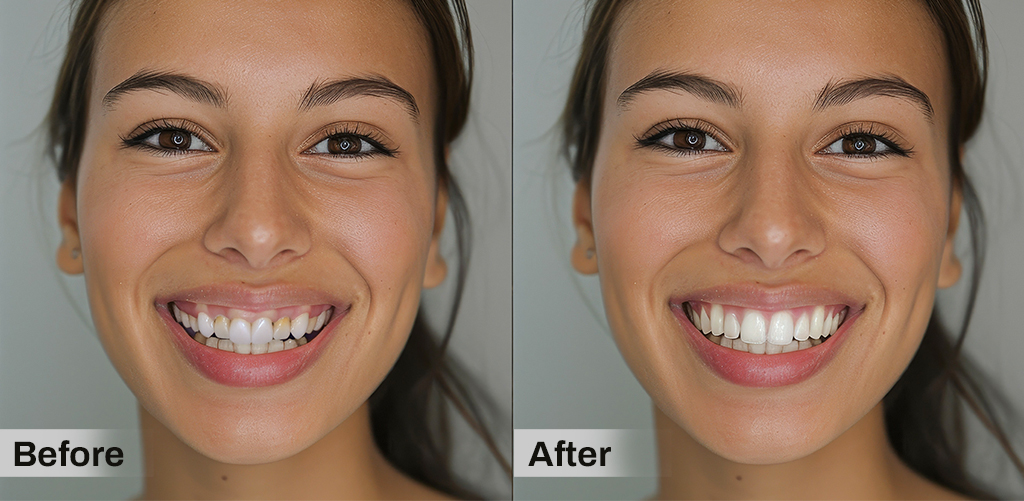
| Crown lengthening is a procedure that exposes more of the tooth surface to improve the smile. For a single tooth, the cost typically ranges from $150 to $400. On the other hand, when several teeth are involved, the cost can range from $3,000 to $5,000, depending on the complexity of the case. |
What Is Crown Lengthening?
Crown lengthening involves reshaping the gum tissue and sometimes the underlying bone to show more of a tooth’s surface. It is done to improve a gummy smile.
Many people choose this procedure to show more teeth and less gum when smiling. All in all, crown lengthening helps create an adequate tooth structure for dental restorations, such as crowns or bridges. If you ask, ‘Who does crown lengthening?’, the answer is a periodontist (a gum specialist).
Between 10.5% and 29% of young adults have a gummy smile, and it’s more commonly seen in women.
Source: National Library of Medicine
How Much Does Crown Lengthening Cost?
Crown lengthening costs can change depending on a few things, like where you go, how complex the procedure is, and whether it's for health or looks.
Usually, it costs around $150 to $400 for one tooth. But if more teeth are involved or if bone needs to be removed, it can be more expensive.
If you're getting crown lengthening because it's needed for another dental treatment, like a crown or fixing gum disease, your insurance might help cover the cost. But if you're doing it just to improve your smile, insurance usually doesn’t pay.
💳 Need Help Paying for Crown Lengthening?
Flexible dental financing is available with no credit checks and instant approvals.
👉 Explore Credee Payment PlansReasons Why You Need Crown Lengthening
1. Restorative or Functional
Crown lengthening is sometimes needed when there's not enough of a tooth showing above the gums. This can happen if a tooth is broken below the gum line or has a cavity that goes too deep. In such cases, the dentist removes a little bit of gum and sometimes some bone. So they can reach more of the tooth. Moreover, some people have naturally short teeth or teeth that are worn down, which makes it hard to place a restoration. This is where crown lengthening helps.
2. Cosmetic
It is often done to improve the way a smile looks, especially if someone has a “gummy smile.” In this procedure, the dentist carefully removes some of the extra gum tissue and reshapes it. Therefore, it makes the teeth look longer and the smile more even. It’s often part of a full smile makeover, along with treatments like whitening, veneers, or crowns.
Just a little change in the gum line can really improve a smile. It often helps people feel more confident and proud of the way they look.
3. Periodontal
This treatment supports patients with conditions like periodontitis, where the gums separate from the teeth and form deep, hard-to-clean pockets. Sooner or later, these pockets trap bacteria and plaque, which are hard to clean. Over time, this can make the disease worse.
Crown lengthening removes the excess gum tissue and reduces the size of the pockets. It enables you to clean your teeth and gums more effectively. After this, you can easily clean your teeth and gums properly. Moreover, it helps to stop the spread of infection and protects you from further damage, like bone loss or losing a tooth. It’s a helpful way to keep your mouth healthy for the long term.
Crown Lengthening Procedure
1. Numbing the Area
First, your dentist or periodontist will give you a local anesthetic (a numbing injection). This way, you’ll be awake but won’t feel anything in the treated area.
2. Making Small Cuts in the Gums
The dentist makes a cut in the gum tissue after numbing the area. It helps to move the gum away and expose more of the tooth.
3. Removing Excess Gum (and Sometimes Bone)
Next, they will remove a small amount of gum tissue. In some cases, they may also remove a tiny bit of bone around the tooth to show more of the tooth’s surface. This step is done carefully to avoid damaging the tooth or nearby areas.
4. Cleaning the Area
After reshaping the gums (and bone if needed), the dentist will clean the area thoroughly to prevent infection.
5. Stitching the Gums
The gum tissue is then stitched back in place using small stitches. These stitches help the gums heal in the new position.
6. Placing a Bandage (Optional)
Sometimes, a small protective dressing or bandage is placed over the area to protect it while it heals.
7. Healing and Recovery
You’ll be given instructions on how to care for your mouth at home. This may include painkillers, a special mouth rinse, and advice on what to eat and avoid. Stitches are usually removed in 1–2 weeks, and full healing takes a few weeks before any final dental work (like a crown) is done.
🦷 Ready to Take the Next Step?
If you’re considering crown lengthening, we can help make treatment more affordable. Explore flexible financing options with Credee—no credit check required.
👉 Schedule a Consultation or Apply for FinancingWhat to Do Before Your Dental Treatment
1. First, Talk to Your Dentist or Gum Specialist
They’ll check your teeth and gums, take X-rays, and explain why the procedure is needed. Sometimes, they may also take molds of your teeth to plan things better.
2. Next, Share Your Medical History
Let your dentist know if you have any health problems, like diabetes or heart issues. Also, tell them about any medicines or vitamins you take, especially blood thinners. Because you might need to stop them for a while.
3. A Few Days Before the Procedure, Avoid Smoking and Alcohol
These can slow down healing. Therefore, it’s best to stop before and after the treatment.
4. On the Day of Your Appointment, Eat Something Light Before You Go
Since your mouth will be numb afterward, it might be hard to eat for a few hours.
5. Before the Procedure, Check if You Need Any Medicines
Your dentist might give you a prescription for painkillers, antibiotics, or a special mouthwash. Indeed, it’s a good idea to get these ready ahead of time.
6. If You’re Getting Sedation, Ask Someone To Drive You
You may feel sleepy or dizzy afterward, so it’s safer to have someone take you home.
Crown Lengthening: Tips for a Smooth Recovery
Recovery usually takes a few weeks after the procedure. During this time, following your dentist's instructions is crucial.
1. Right After the Procedure
Your mouth will stay numb for a few hours. While it’s still numb, don’t eat or drink anything hot so you don’t burn yourself or bite your tongue or lips by mistake.
2. In the First 24 to 48 Hours
After the treatment, you may feel a bit sore or notice some swelling or a little bleeding. Use an ice pack on your cheek to help. Just keep it on for 15 minutes, then take it off for 15 minutes. Additionally, try to stay away from spicy or crunchy foods, and don’t poke the area with your tongue or fingers.
3. Healing Phase
Your dentist may prescribe pain relievers, antibiotics, or a special mouth rinse. Take all medications as directed to help prevent infection and manage pain. Moreover, avoid eating hard foods. Instead, eat soft foods like yogurt, soup, mashed potatoes, or scrambled eggs for the first few days.
4. When It Comes To Brushing
You can continue brushing your teeth, but be very gentle around the treated area. Your dentist may suggest avoiding flossing near the site until it has healed a bit more.
5. After a Week or Two
You’ll likely have a follow-up visit. The dentist will check how your gums are healing and may remove any stitches if they were placed.
6. Full Healing
It usually takes a few weeks and depends on the person and the extent of the procedure. Also, if you’re planning to get another dental work afterward, you should wait until the gums have completely healed before continuing.
Crown Lengthening Before and After Images
Check out these images to see the results of crown lengthening treatment.

Is Crown Lengthening Right for You?
Crown lengthening might be a good choice for many people. For example, if you need a crown or filling but not enough of your tooth is showing, this treatment can help by exposing more of the tooth so the dental work stays in place.
Some people also choose it to fix a “gummy smile,” where the teeth look too small because there’s too much gum showing. It can also help people with gum disease by making it easier to clean deep spaces between the teeth and gums.
And if your teeth are naturally short or have been worn down, crown lengthening can make more of the tooth visible so your dentist can treat it properly. In the end, your dentist will decide if this is the right treatment based on your dental needs.
Conclusion
Oral surgeries like crown lengthening are quite common these days. This procedure helps improve your smile and fix certain dental problems. However, it can be complex and needs special care from a dental professional.
When it comes to the cost, crown lengthening can be expensive, and many patients may not be able to pay for it right away. That’s where dental financing options like Credee can help. Credee offers dental payment plans that are easy to get, with no credit checks and a 97% approval rate. This means patients can start their treatment without having to wait or worry about money.
Don’t Delay the Treatment You Need
With Credee, you can begin treatment today without credit check barriers.
👉 Apply Now – It Only Takes 2 MinutesFAQs
1. Is Crown Lengthening Painful?
It is usually not painful as the area is numbed during the procedure. Although you might feel a little discomfort afterwards.
2. How Much Does It Cost To Lengthen a Crown?
The cost to lengthen a crown typically ranges from $150 to $400 per tooth. The cost may increase if more teeth are involved.
3. What Are the Downsides of Crown Lengthening?
There is a risk of tooth infection and tooth sensitivity. Also, the treated tooth can appear longer as compared to the surrounding teeth.
4. What Are the Different Crown Lengthening Healing Stages?
After crown lengthening, your gums may feel sore and swollen for a few days, but they start to heal in about 1 to 2 weeks. Full healing usually takes 6 to 8 weeks, and your dentist will wait until then to finish any dental work.
5. Will Insurance Cover Crown Lengthening?
Insurance may cover crown lengthening if it’s medically necessary, like for placing a crown or treating gum disease. However, if it’s done for cosmetic reasons, most insurance plans won’t cover the cost.
💬 Still Have Questions?
We’re here to help you understand your dental financing options.
📩 Write to Us





